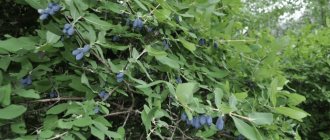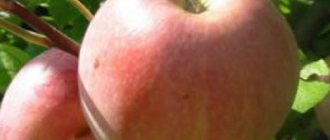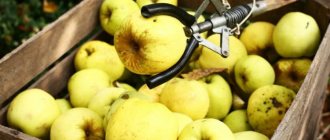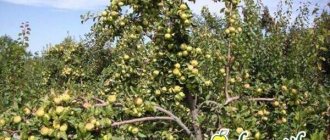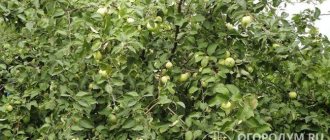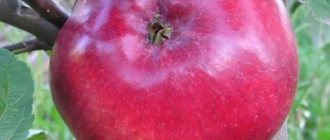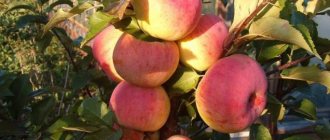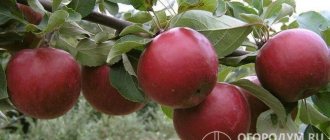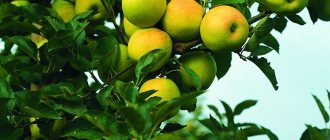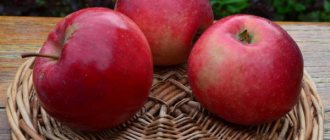The Zvezdochka apple tree is a late-ripening variety. It appeared more than half a century ago, but has not lost its popularity among modern summer residents. The fruits are intended for consumption in winter, and many people who grew up in Soviet times perceive these bright and fragrant apples as “New Year’s apples.” They were often used to decorate holiday trees and complement children's gifts.
A distinctive feature of the “Zvezdochka” apple tree variety (pictured) is dark cherry fruits covered with a thick waxy coating with wide ribbing, outlines reminiscent of a star.
In the article we will talk in detail about this type of culture and start with the main characteristics:
| Parameter | Characteristic |
| Culture | Apple tree (Malus domestica Borkh.) |
| Variety | "Star" |
| Tree height | Vigorous - up to 5-5.5 meters |
| Terms of removable (technical maturity) | Late September – early October |
| Consumption period (fruit shelf life) | Winter – until February-March (207 days) |
| Precociousness | 4-5 years after planting (depending on the rootstock) |
| Type of fruiting | Mixed (on twigs and spears, less often on young ringlets) |
| Productivity of an adult tree per season | Moderate – from 57 to 80 kg, annual |
| Size and weight of fruits | Average and below average size, weighing 60-100 g |
| Shape and color | The apples are round, with a small wide ribbing on the side of the stalk. The color of the skin is uneven: the main skin is light green, the outer skin is in the form of a blurred dark red (cherry) blush. The entire surface of the fruit is covered with a strong waxy coating |
| Professional appearance assessment | 4.8 points (out of 5) |
| Fruit pulp | Juicy, dense, fine-grained, greenish (in intensely colored fruits there is a pink tint to the skin) |
| Tasting assessment (taste qualities) | 4.6 points (out of 5) – sweet and sour taste |
| Purpose of fruits | Dessert (universal) |
| Sustainability | Average winter hardiness (in northern regions there is a risk of freezing without shelter); slightly affected by scab |
| Year of inclusion in the State Register of the Russian Federation | 1972 |
| Recommended growing regions | Northwestern (2), Central (3), Volga-Vyatka (4) and Middle Volga (7) |
| Originator | Federal State Budgetary Institution "Federal Scientific Center named after. I. V. Michurina" (Tambov region) |
Origin and zoning
The variety was created in the late 20s of the last century by domestic specialists (author - S. F. Chernenko) at the All-Russian Research Institute of Genetics and Selection of Fruit Plants named after. I. V. Michurin by crossing “Lithuanian Pepinka” with “Anise”.
Apple trees 'Pepin Lithuanian' (left) and 'Anise' (right) used as parent forms
After successfully conducted state variety tests, “Zvezdochka” was officially registered in the State Register of the Russian Federation in 1972. The apple tree is quite widespread in many regions of Central Russia, and is perfectly adapted (zoned) to the climatic conditions of the North-Western, Central, Volga-Vyatka and Middle Volga regions. Favorably differing in taste and marketability of fruits, this variety did not leave amateur gardeners indifferent, who are still actively growing it in many countries of the post-Soviet space.
Detailed description of the Zvezdochka apple tree variety
The distribution area is extensive; it is grown throughout almost the entire territory of Russia, except for the Far North.
The winter apple tree is characterized by high shelf life. A tall, powerful plant with a round, spreading crown, reaches a height of 4.5-5.5 m, and a crown diameter of up to 6 m.
It is characterized by thick skeletal branches, thin elongated red-brown shoots, with strong pubescence downwards. Leaves are finely serrated, oval, short-petiolate. The variety has a high growth rate; growth during the growing season is 10-20 cm.
The fruits are initially light green, smooth, flattened-round in shape, with slightly pronounced ribbing. This was the reason for the name of the apple tree - Asterisk. The top color is bright red. It has a lot of positive qualities and advantages over its analogues and is highly valued by gardeners. They are propagated by grafting, so you need to purchase it from a nursery.
Medium-sized apples, weighing 120-140 g, with a waxy coating on a thick skin. The juicy pulp of the fruit is white, sometimes with a greenish or pinkish tint. The seeds are brown, small, but not numerous. The fruits have a sweet and sour taste, medium friability. Sugar level – no more than 10%.
Main advantages:
- stable regular fruiting;
- high taste qualities;
- excellent presentation;
- long period of storage of fruits;
- persistent immunity to diseases.
The harvest is harvested from September until the onset of frost. Apples reach full consumer ripeness in a month, if properly stored.
The maximum yield from one mature tree reaches 130-160 kg per tree. If all storage requirements are met, the fruits retain all their taste and shape for 200 days, until spring.
The Zvezdochka apple tree also has its disadvantages:
- average frost resistance (up to -25 degrees);
- crushing of fruits and taste qualities with each year of fruiting;
- the need for annual pruning;
- susceptibility to fruit rot.
To save space, gardeners practice propagation on a columnar rootstock. After 2-3 years, a wedge-shaped dwarf tree grows and bears fruit, which can be planted at a distance of 50-60 cm from each other in the same row. They begin to bear fruit 1-2 years earlier than their classic tall counterparts.
Reviews from gardeners
Semyon 45 years old, Perm region
Favorite variety. It has been growing in our garden for twelve years. We pick the green fruits with a bright red blush at the end of September, still a little unripe. Around November they turn dark cherry. The longer they sit, the better it tastes. The pulp is juicy, crispy with an amazing honey aroma. The medium-sized fruits are ideal for canning; they make rich and aromatic compotes. We use small apples (50-75 g) with elegant colors as decorations on the New Year tree.
Svetlana, 61 years old, Prokopyevsk
We must cover the tree for the winter. Unfortunately, in our area, during severe frosts, flower buds froze, but the apple tree was strong and quickly recovered. For ten years now I haven’t “rested” even once. During all this time, the apple tree did not get sick. But the older you get, the more small apples there are. To maintain the same size, we regularly thin out the crown and apply fertilizer. We carry out pruning in early spring, removing dry and intertwining branches. During dry summers we water much more often than usual.
Marina, 65 years old, Kaliningrad region
Our apple tree has been pleasing us with harvests for almost twenty years, regularly producing more than 60 kg every season. Unfortunately, the fruits began to shrink. We make sure that the branches do not creep up, but grow to the sides. We shorten the top. With the arrival of autumn, when the tree sheds its leaves, we remove dry branches and those that are not growing properly. Be sure to cover the cuts with garden varnish. We practically do not treat diseases and pests. We collect fruits carefully to avoid mechanical damage. We store in the cellar until February - March. It is best to place the harvest in wooden boxes pre-treated with a solution of potassium permanganate. Then, over a few days, I dry them well in the sun, covering the bottom with sawdust or thick paper. In our cellar the air is very damp, so around the boxes we place containers with fluffy lime, which perfectly absorbs excess moisture. The neighbors, on the contrary, have a basement that is too dry; they use sand, regularly watering it with water, so that the air is moistened as it dries.
Characteristics of the apple tree Asterisk
It is popular due to its high yield, beautiful appearance of the fruits, and their high taste. There are certain benefits of eating these apples:
- normalization of the digestive system;
- stabilization of gastrointestinal tract functions;
- neutralization of oxalic acid in the body;
- strengthening the immune system.
The high content of vitamin C in fruits helps strengthen the body. The aromatic, tasty fruits are consumed fresh; juices, compotes, jams, and jelly are made from them. Canned apples have proven themselves to be excellent.
Features of ripening and fruiting
Fruits can ripen even after harvesting
Winter apple trees bear fruit in the fall. After planting, the apple tree will bear its first fruits in 6 years.
If it is planted on a dwarf rootstock, then the first harvest can be expected after 3 years.
The variety's fertility is average, with a moderate amount of apples. About 100 kg per year is collected from an adult tree.
The fruits ripen even after harvesting; if you collected them in September, then by October you can already consume them.
Beginning of fruiting
Before flowering begins, namely before the foliage appears, pruning is necessary.
By removing excess branches and dried twigs, the gardener ensures high-quality flowering and prevents the tree from annually reducing the size of the fruit. Trees begin to bear their first fruits after an average of 5 years.
The first harvest will be small, but every year it grows.
Timing of flowering and fruit ripening
This fruit variety is a late-ripening apple tree and produces a harvest much later than other trees. The buds open and flowering begins only in May.
Harvest and storage
Gives a fully ripened harvest in September. You can collect by October, but if the apple tree begins to shed its fruits, you should not delay the collection.
The filling can also ripen in the cellar or in special wooden boxes. It will not deteriorate and lose its presentation thanks to the generous wax coating. It preserves the fruit for as long as possible and protects it from rotting and withering.
Landing
The site for future planting is dug up in the fall and fertilizers are applied: peat and wood ash. It is recommended to plant seedlings in the ground after the threat of spring frosts, then the survival rate of the young tree is much higher. Depending on regional characteristics and temperature conditions, apple trees are planted from April 15 to May 20. The soil should be sufficiently warmed up by this time.
The landing site should not be shaded. The distance between trees is at least 4-5 meters. Young trees should not be planted near old stumps or plants affected by diseases. The soil on the site should have a low level of acidity. It is advisable to choose areas with loamy, podzolic, sandy loam soil.
The seedling chosen is one or two years old, with an even trunk and bark, without visible damage. A hole is dug measuring 1x1 m in width and depth. A drainage layer (crushed stone, stones, broken brick), no less than 10 cm, is poured onto the bottom. A soil mixture is poured on top: humus, turf soil and ash. The roots are placed on its top, spreading them to the sides. Sprinkle and water generously. The root collar should be above the ground at a height of 7-8 cm, tied to a support.
To actively set fruit, the apple tree needs pollinators. For this purpose, only winter varieties are selected: Antonovka, Bogatyr, Memory of the Warrior. The number of pollinating trees should be one third of the Asterisk.
Positive and negative sides
Among the many advantages of this apple tree, the most valuable are:
- resistance to major diseases and crop pests;
- ability to quickly recover after freezing;
- moderate but annual yield;
- excellent taste and marketability of fruits;
- long shelf life and the ability to transport over long distances.
The disadvantages of the variety include average winter hardiness, low early fruiting, and smaller fruits in mature trees. It is important to take into account that “Zvezdochka” is self-sterile, so it is necessary to plant nearby pollinating apple trees of other varieties that bloom at similar times, for example, any varieties of “Antonovka”, “Bogatyr”, “Zhigulevskoe”, “Memory of the Warrior” and others.
Care
The asterisk requires regular care. From early spring, preventive inspections of trees are carried out: the bark on the trunks and the condition of the branches are studied. If cracks and foci of peeling are detected, they are treated with special compounds to avoid the occurrence of diseases and infections. Remove moss and lichens and remove growths.
In autumn and spring, the trunks are whitewashed with lime. A groove is dug from the circle around the trunk to drain excess water; the root system should not remain in water for a long time. In the hot season, watering should be plentiful. A prerequisite is to remove weeds and loosen the soil around the trunk. On poor soil, seedlings need fertilizing; this is usually done in the fall. In the spring, add humus, peat or compost.
Pruning and crown formation are required. This procedure is carried out immediately before planting or in early spring, before the leaves bloom. The branches are cut by 1/3 with sharp pruning shears, which are disinfected before the procedure. The cut areas are treated with a solution of lime and copper sulfate, and later with garden pitch. Diseased shoots and dry damaged branches are also removed. If necessary, the tree is treated with insecticides against pests.
To retain moisture during dry periods, the soil is mulched. Peat, hay, straw, leaf humus, and tree bark are used as mulch. The mulch layer should not be less than 10 cm.
Caring for the fruit crop Zvezdochka
It is necessary to periodically fertilize the tree with useful microelements. This helps stimulate growth. It is best to mix them with soil. In the fall, in November, the first fertilizing is carried out using phosphorus-potassium fertilizers.
In the spring, manure or leaf humus is poured into the tree trunk circle under the tree. The apple tree does not require special care, as it is an unpretentious crop. She needs to further ensure soil mulching and watering.
Crown trimming
Forming the crown of a tree and pruning it are a prerequisite for caring for the crop. Failure to comply with this condition may lead to a decrease in yield. Rejuvenating pruning helps prevent fruit shredding.
After planting the variety, the first pruning should be carried out. To do this, cut off a third of all branches. Subsequently, pruning is performed every spring. Strong shoots are left, weak, damaged, dry shoots are removed.
Apple tree Zvezdochka needs pollinators
The apple tree needs pollination with other varieties. These can be Zhigulevskoe, Bogatyr, etc. apple trees. This is important for fruit set.
The tree blooms at the end of May, later than other apple trees. Ovaries form on twigs, and sometimes on ringlets. During ripening, fruit shedding begins. The harvest is harvested very early - already in mid-September.
Storage
The temperature of the cellar, the room where the fruits are stored, should be no more than 0 degrees. The fruits continue to ripen during the storage period. They retain a presentable presentation for 6-8 months, due to the presence of a waxy coating on them. Clean, dried containers and wooden boxes are suitable for storage.
Pests and diseases
Although the variety has excellent immunity, preventive measures against pests should be carried out regularly. If branches and leaves are affected by powdery mildew, they are treated with Topaz. Fundazol will help in the fight against rot. When affected by scab, the tree is treated with Horus.
Pest protection
Apple trees of the Zvezdochka variety have a fairly strong immunity; they are practically not affected by scab. If signs of the disease appear, treat with chemicals before and after flowering. Special drugs for combating diseases have proven themselves to be excellent:
- "Horus." In the spring, trees affected by scab are treated: 1 ampoule per 10 liters of water.
- "Fundazop". It is used when fruits are affected by rot: dilute 45 g of the product in 10 liters of water.
- “Topaz” For signs of downy mildew on leaves and flowers, treat with the drug at the rate of: 1 ampoule per 10 liters of water.
- "Karbofos" and "Chlorofos". Spray three times during the growing season in the following proportions: 20 g of chlorophos and 30 g of karbofos per 10 liters of water.
Trees affected by apple worm are treated by fumigation. In the evening, if there is no wind, wet straw is laid out between plantings and sprinkled with tobacco dust. The smoldering process must continue for at least 2 hours.
In winter, to prevent damage to plantings by rodents and hares, the trunks are wrapped with protective materials: burlap or nylon tights. They install special protective nets.
Analogs of the variety
There are several varieties with similar properties and indicators that are cultivated on a par with Zvezdochka.
Antonovka vulgare
This is a very common apple tree with a large and wide crown. The apple tree is considered very productive; there is evidence of 500 kg of fruit collected from one apple tree. The variety is unpretentious, for which it is valued by gardeners in the Russian Federation and its environs.
Apple tree Antonovka Ordinary.
Anise striped
A vigorous winter apple variety with a wide spreading crown and a long lifespan. Anise apples are very tasty, aromatic and sweet and sour. The apple tree is high-yielding, unpretentious and very common, considered one of the oldest varieties.
Apples of Anise Striped.
Cinnamon new
Quite a new autumn ripening variety. The fruits are picked from the apple tree in early October and stored for about 4 months. The culture has good immunity, but needs protection from low temperatures.
Apple tree variety Cinnamon new.
Fruit storage
Fruit ripening on Zvezdochka begins in mid-September. Fruits picked in time retain a presentable appearance for a long time. An intact wax coating on apples guarantees their preservation in their original form for up to six months.
The harvest is stored in a wooden container, previously washed and dried. Cardboard boxes with holes for ventilation are less commonly used. Apples are folded in one layer, less often - in 2 layers, tightly to each other. The room is selected with a temperature range from 0 to 2 degrees Celsius: cellar, basement, vegetable storage or insulated loggia.
Place of birth and distribution
Officially, the regions of its zoning are the Central regions of Russia: Northwestern part, Central, Middle Volga, Volko-Vyatka.
In the southern regions, the adaptation of apple trees is not bad. in the northern parts, where winters are longer and frostier, since the variety is not highly frost-resistant.
The following varieties of apple trees are also suitable for planting in the indicated zoning regions: Calvil snowy, Cinnamon new, Uspenskoye, Pepin Shafranny and Young Naturalist.
Preparing Zvezdochka for winter
A fact that has long been proven in practice is that successful wintering of trees takes place only if there is sufficient moisture in the spring-autumn period. Complex fertilizing with mineral and organic fertilizers will significantly strengthen the apple tree’s immunity and increase the tree’s chances of a safe winter. A thick layer of mulch will protect the trunk from frost and rodents. The surrounding circle is covered with stalks of corn, sunflower, raspberries and blackberries.
In areas with a frosty climate, trees are additionally “insulated” by wrapping the trunks with agrofibre, spruce branches, and rags. It is not recommended to use wire for fixation; there is a risk of damage to the bark. Secure insulation materials with tape or strips of fabric. The work is carried out late in the fall, when the sap flow process is completed.
Particular attention should be paid to young apple seedlings planted in the spring. Frail trees may suffer or die during a sudden cold snap. They are completely wrapped: trunk and crown. Adult apple trees are more frost-resistant.
Growing in regions
Asterisk is easiest to grow in the middle zone, where the climate is temperate. But it is possible to grow it in different regions.
Moscow region
The climate of the Moscow region, although considered moderate, can be quite harsh. The fact that the apple tree does not suffer from scab ensures good survival rate. But in winter, when temperatures are low, the tree can suffer greatly, so it will be necessary to provide good shelter.
North-west Russia
In this territory of Russia it is best to grow a dwarf rootstock. This achieves much greater resistance to low temperatures, but reduces the amount of yield.
Central Russia
In this region, apple trees are grown without any problems at all. Here it is very popular among gardeners and does not freeze.
Resistance to diseases and pests
Bulk is known for its invulnerability to scab, but it is still recommended to treat it with fungicides to avoid infection with other fungal diseases and protect against viruses.
The most popular means of struggle:
- Horus;
- Topaz;
- Fundazol;
- Carboforce.
Prevention is carried out in three stages: in the spring, before the appearance of buds; when flowering; and then in the fall, before the cold weather.
Carefully inspect the lower part of the trunk and branches: this is how an experienced gardener can diagnose the presence of fungus or a cluster of insects and remove them.
Optimal growing conditions
A tree with average frost resistance develops well and produces the expected yield in areas of the middle climatic zone. Farther north, the Zvezdochka apple tree is not grown; the branches freeze in winter. In the southern regions, the tree requires regular, abundant watering for natural development. The Zvezdochka variety is placed in a spacious place, especially making sure that the seedling is not shaded by old fruit trees. You cannot plant an apple tree near tall decorative deciduous trees, which will inhibit the fruit crop. It is better to plant the fruitful fruit variety Zvezdochka next to other winter apple trees: Belorusskoe Raspberry, Bogatyr, Ladoga, Antonovka of various varieties. Experienced gardeners increase the frost resistance of Zvezdochka by planting winter-hardy varieties inside the crown - Cinnamon Striped, Sharopai, Anise.
Select a site for an apple tree:
- with weak acidity, pH 5.7-6.0;
- where loams, sandy loams or soddy-podzolic soil predominate;
- with deep groundwater;
- not in the place of uprooted apple or pear trees.
Description
The apple tree is a tall tree with thick skeletal branches and thin twigs. The shoots are dark brown, elongated, with strong drooping towards the bottom.
The green foliage on short petioles has a round-oval shape with jagged edges.
The fruits are light green in color with characteristic red streaks over the entire surface. The apples are round, with pronounced ribs, which gave the variety its name – Zvezdochka.
The fruit crop matures in autumn and has a lot of advantages that are valued in gardening.
Having considered all the characteristics of the variety, it will be possible to extract useful information about the plant and learn all the nuances about the fruiting of this apple tree.
